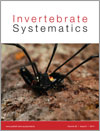Members of the New Zealand Enantiobuninae constitute some of the most charismatic soil arthropods of the archipelago, and a striking example of sexual dimorphism, with nondescript females but colourful males boasting exaggerated chelicerae many times longer than their bodies. The genera Forsteropsalis and Pantopsalis recently underwent revision, but many questions remained about the validity of species designations owing to historical issues of characters of dubious taxonomic value, female specimens designated as holotypes despite the males holding all the diagnostic characters, and the suspected presence of more than one male form within some species. We present the first phylogeny based on molecular data for the New Zealand species in the genera Forsteropsalis, Pantopsalis and Mangatangi, and comment on the taxonomic implications of our results, including the diagnostic viability of important morphological characters. Our analyses reject the monophyly of Neopilionidae and Forsteropsalis, but support the monophyly of Pantopsalis. Finally, we comment on the taxonomic implications of the results, including the diagnostic validity of morphological characters traditionally used on the groups.
How to translate text using browser tools
19 December 2014
A molecular phylogenetic approach to the New Zealand species of Enantiobuninae (Opiliones : Eupnoi : Neopilionidae)
Vélez Sebastián,
Fernández Rosa,
Giribet Gonzalo
ACCESS THE FULL ARTICLE

Invertebrate Systematics
Vol. 28 • No. 6
December 2014
Vol. 28 • No. 6
December 2014
Australia
biogeography
Monoscutidae
phylogeny




